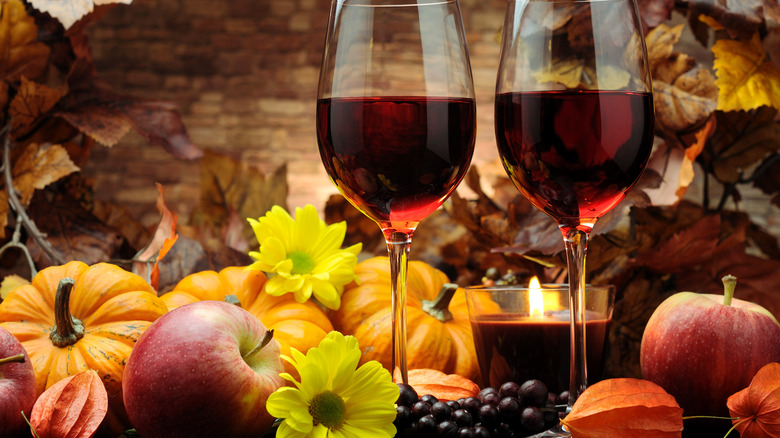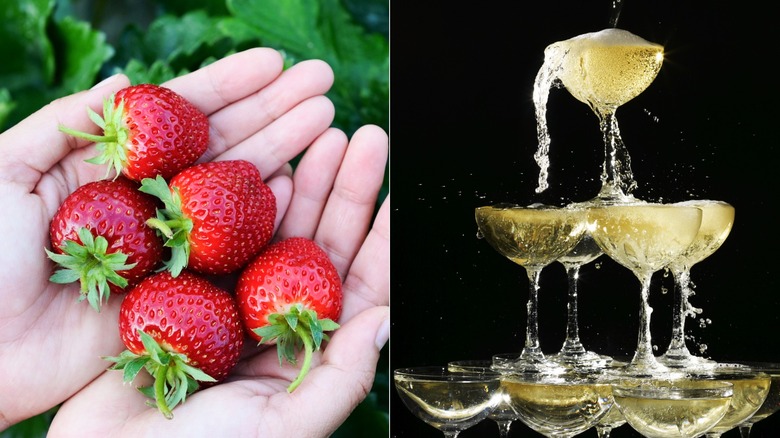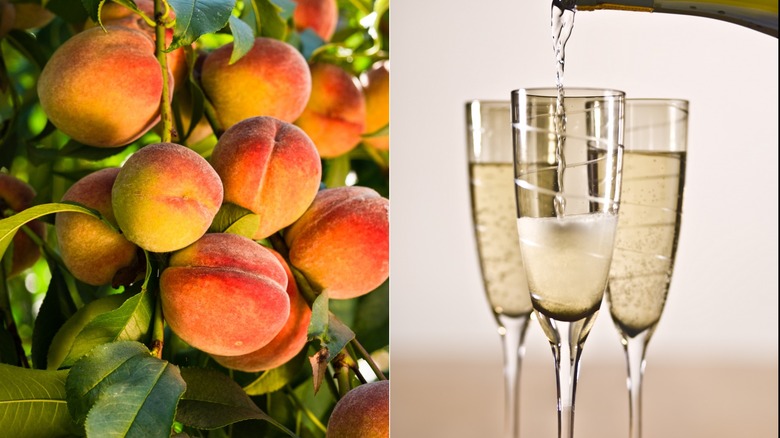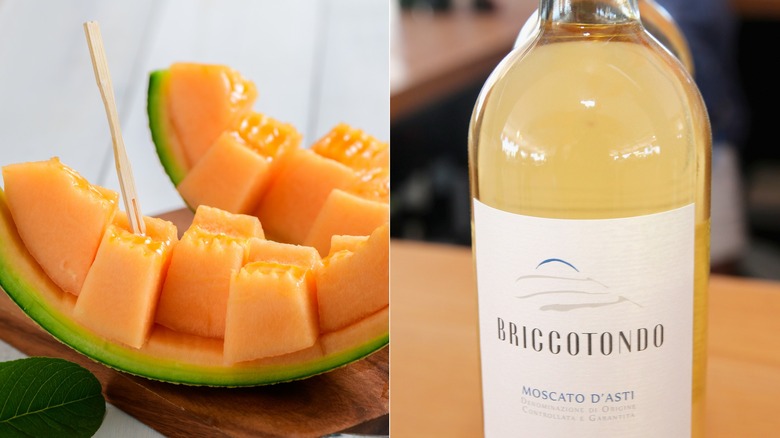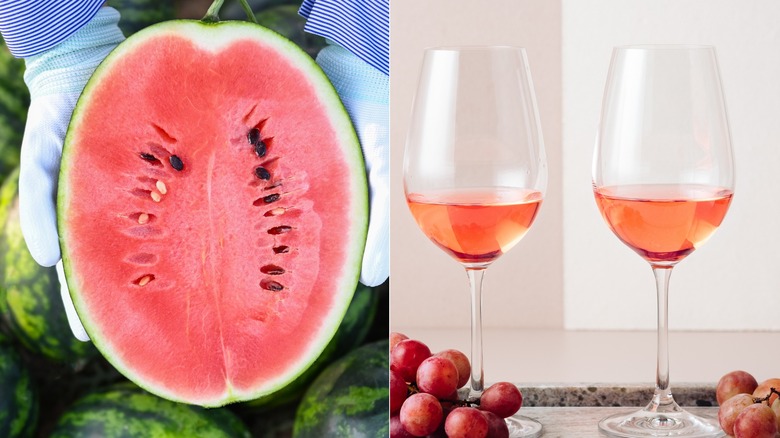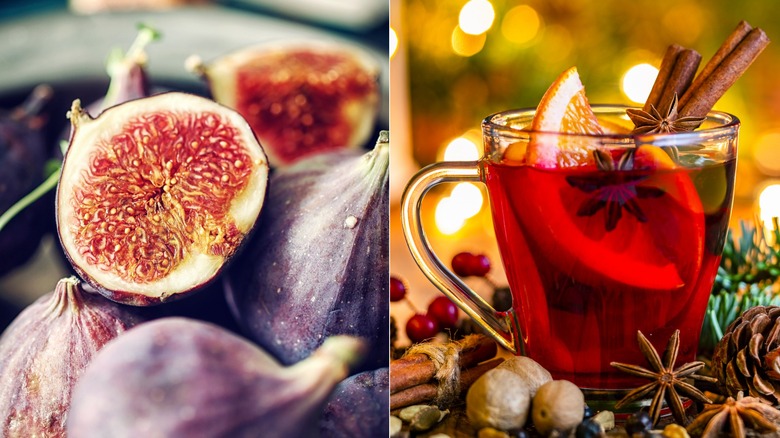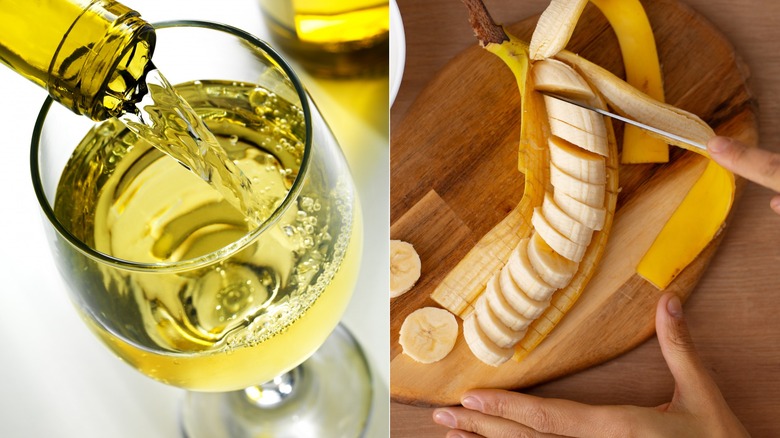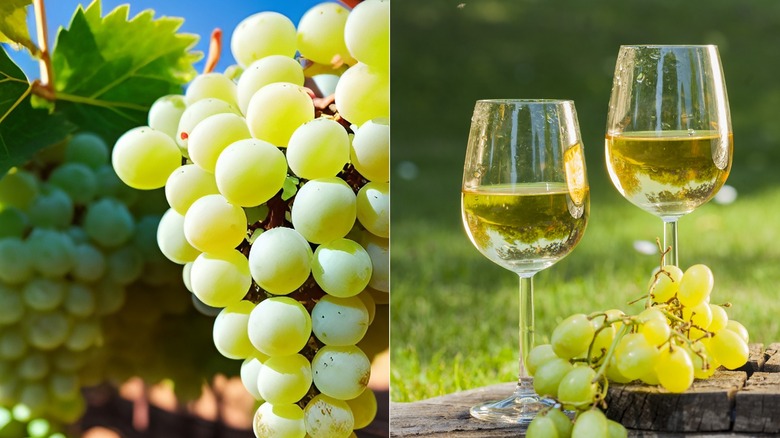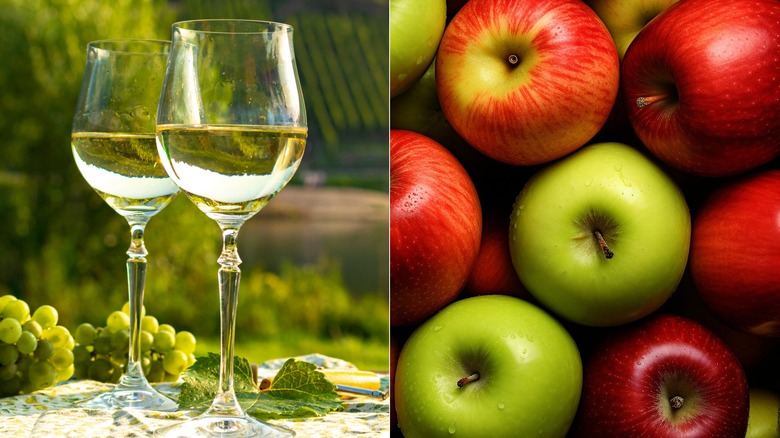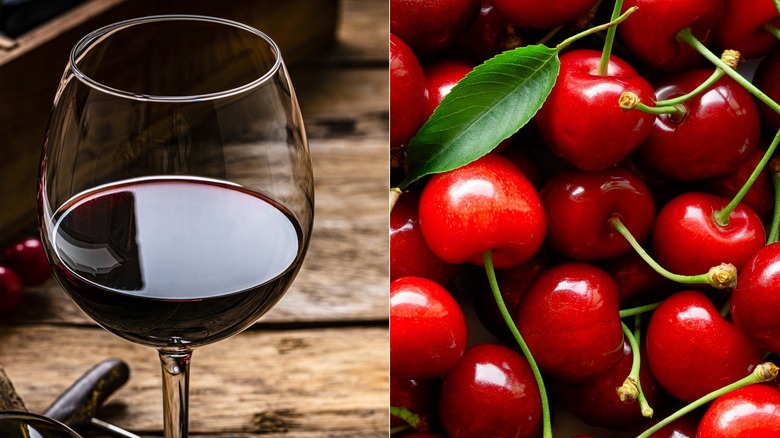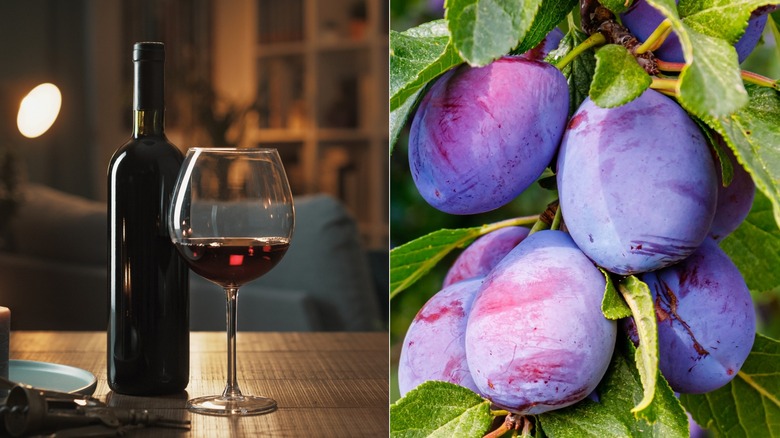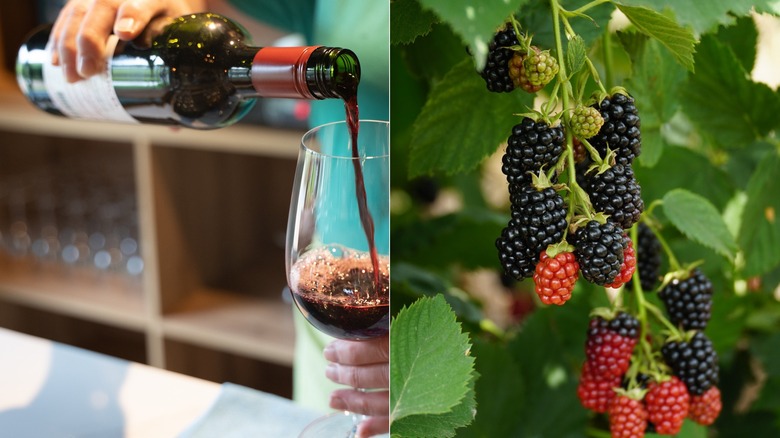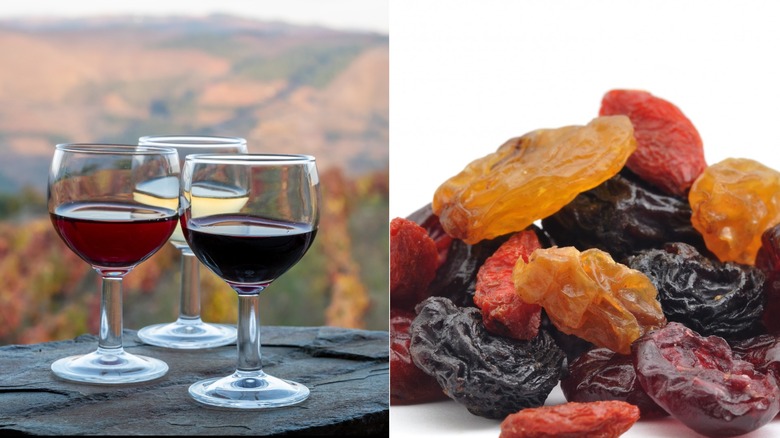13 Wines To Pair With Fruit During The Holiday Season
With the holidays fast approaching, it's time to think not only about festive fruits but the wines that you can pair with them. Key considerations when you're doing so include the flavor profiles of both fruit and wine. A light, crisp white such as sauvignon blanc or pinot grigio will be a nice complement to citrus fruits like oranges and grapefruits. Meanwhile, a fruity and medium-bodied red like zinfandel will go happily hand in hand with juicy and slightly tart berries. Stone fruits, such as peaches, nectarines, and apricots, offer a juicy sweetness that pairs beautifully with off-dry white wines like riesling or gewürztraminer.
When you're considering wine and fruit pairings, you should also pay attention to the texture and ripeness of the fruit. Crisp and slightly tart green apples, for example, make for a fine pairing with a chardonnay or Prosecco, with the wine's acidity acting as a palate cleanser. You can take it a step further if you like, bringing in tropical fruits like pineapples and passion fruit and matching it with a viognier or an albariño. These might feel somewhat unusual for the Christmas season, but then again, is there a better time in which to pretend to be somewhere sunnier and warmer? With that being said, here are 13 wines that you can pair with fruit for the holiday season.
Champagne and strawberries
There are few wine and fruit pairings as classic as Champagne and strawberries. Granted, for a lot of people, that means the strawberry Champagne cocktail, which involves pureeing the fruit and turning it into a simple syrup to be stirred in. The association, in many cases, is with Valentine's Day or any other romantic occasion, but the two are irrevocably linked in most people's minds as a symbol of love, which makes them perfect for the holiday season as well.
Rosé Champagne is a good choice as the wine because of the hint of red currant, raspberry, and strawberry that is usually found in the aroma and even lingering in the taste. Sweet and slightly tart, strawberries are an excellent complement to the effervescent, crisp, and acid taste of a good Champagne. Dip them in chocolate if you so desire, but a plate of ripe strawberries unburdened by any extra flavoring really can't be beaten. If you're looking to add to the fruit plate, the vivacity of Champagne also nicely complements raspberries, cranberry, and pomegranate seeds as well.
Prosecco and peaches
We're going to pause here and clarify the difference between Champagne and Prosecco, which are both sparkling wines made from different grapes in different geographic regions. To put it in simplest terms, we can only refer to a wine as Champagne if it comes from the region of the same name in France, whereas Prosecco is mostly made in the Veneto region of Italy. Now that we have that out of the way, Prosecco is very versatile with fruit pairings, but especially so with stone fruits.
The sweetness of peaches is particularly excellent for matching the effervescence and acidity of Prosecco, so much so that the peach Bellini was created to highlight it. Eating a raw peach with a cold glass of Prosecco is a pleasure in itself, but added whipped cream makes for a delightful dessert. Grilling your peaches is also an excellent way to go about it if you're not already slammed with holiday dishes on the stove. Other fruits that pair nicely include mango, which adds a tropical touch, the tang of pineapple, or the subtle sweetness of melons.
Moscato d'Asti and melon
A sweet and sparkling, low-alcohol white wine from the Piedmont region of Italy, Moscato d'Asti is probably best known as a dessert wine or an aperitif. In it, you'll taste melon, peach, and apricot, but also wild sage and honey; this makes it perfect for pairing with fruit, especially those with bright and cheerful flavors. Melons come to mind immediately: cantaloupe and honeydew are all excellent choices, providing a juicy and sweet profile that complements the bright acidity of the wine perfectly
This isn't too far off from a traditional meal of the region, with melon adding a sweet component to a plate of fresh bread, salami, and figs. Keep in mind that Moscato d'Asti is different from Moscato, which can be a still wine or even produced as a fortified variant. Remember that the amber-colored Moscato d'Asti varies in sweetness depending on the producer, and while some are gently sparkling, others have drier characteristics and are fully sparkling.
Rosé and watermelon
We're getting summer vibes from this pairing, and who wouldn't want a touch of that to brighten up the darkness during the winter holidays? Rosé is known for light, fruity, and sometimes slightly floral flavors, while watermelon boasts a mild sweetness and a high water content. That makes for a perfectly refreshing combination, a delightful snack, or dessert. They work especially well together as part of a cocktail or sangria.
Look for a watermelon that is heavy for its size; that, plus an orange-y "field spot," will indicate that it's sweeter. As for the wine, look for dry or semi-dry with notes of red berries or citrus, which will act as a complement to the juiciness of watermelon. Rosé from regions like Provence in France, or those from Spain and Italy, are excellent options that typically have a matching flavor profile. While simply cutting up the watermelon and snacking from a bowl is perfectly fine, you can also get a little adventurous and make a watermelon and feta salad.
Mulled wine and figs
Rosé is now enjoyed year-round; it's unlikely that you'll be whipping up a batch of mulled wine any time except in the winter months. A warming beverage made by gently heating red wine and infusing it with spices, fruits, and sweeteners, mulled wine commonly includes cinnamon, cloves, nutmeg, star anise, orange peel, and sugar or honey. You'll want to select a red wine with a bold flavor profile; merlot, zinfandel, and cabernet sauvignon would be complementary to the spices in the mulled wine.
As for fruit to enjoy with this aromatic beverage, you could go in many directions, but figs come to mind as an excellent pairing. This is a bit of a cheat since figs themselves are not actually fruits but the flowers of a tree. That being said, it's the seeds in the flower pod that are the fruit, so we're not testing the definitions too much. Possessed of a sweet and slightly earthy flavor with a pleasingly chewy texture, this Mediterranean staple brings a natural sweetness and a hint of complexity to this food partnership. Care to try? We've got a mulled wine recipe ready to go for you.
Chardonnay and bananas
Here's a food combination that you likely wouldn't have guessed at. Bananas and chardonnay might not be a classic or common pairing, but the two can work together quite well in many instances. That's because Chardonnay is a versatile white wine that comes in various styles, ranging from crisp and unoaked to rich and buttery, all depending on where it's produced and how it's made. If you have a lighter, crisper Chardonnay, it will pair beautifully with the sweetness and creaminess of bananas.
A lighter, unoaked Chardonnay with citrusy and green apple notes will also complement the sweetness of bananas. How the bananas are prepared can also be an important influence on the pairing. Grilled or caramelized bananas will go well with a lightly oaked Chardonnay, adding a layer of complexity to the pairing. The buttery or oaky notes of Chardonnay can also work well with such fruits as apples, pears, or apricots. If you care to do some exploring, there are a few Chardonnay characteristics you should keep in mind.
Sauvignon blanc and green grapes
One of the amusing rumors about Paul Simon's song "Mother and Child Reunion" asserts that the songwriter named it after a restaurant dish of the same name made up of two ingredients: chicken and egg. So, in essence, the mother and the child. The wine (and fruitarian) version of that story would have to be pairing sauvignon blanc with green grapes. Putting aside the fact that sauvignon blanc is made from green grapes, it doesn't necessarily follow that the wine and the fruit that it derived from would go together as a tasty pairing.
They do, however, with the wine's acidity helping to balance the sweetness of the grapes and the citrusy and botanical notes providing contrast to the juicy flavors. As a simple holiday snack, they work together quite nicely, but with a few other ingredients, you can highlight both grape and wine. For example, a salad with green grapes, goat cheese, and a light vinaigrette could be a delightful pairing with your sauvignon blanc.
Riesling and apples
The winter months often make it hard to locate fresh local fruit in many places. One fruit that hangs around for a long time in cellars and warehouses is apples, which last several months past when they're picked in the fall. They're also a very versatile fruit that can work well with whatever wine you've brought out for the pre or post-meal snack. Chardonnay and pinot noir are both notably good for the task, but we're going to highlight riesling as the best wine for apples.
Both dry and off-dry riesling work in conjunction with this common fruit, which also has many flavor profiles. A Granny Smith or McIntosh will be very tart, while the Fuji and Gala are notably sweeter. The slight sweetness of an off-dry Riesling complements the natural sweetness of many varieties of apples, while its acidity helps to cut through the richness of apple-based dishes like tarts. A dry riesling will have a different flavor dynamic, their crisp acidity with citrus and mineral notes providing a refreshing contrast. It's a win-win situation no matter which type you choose.
Cabernet Sauvignon and cherries
If there's a particular combination of flavors that just screams sumptuousness, it's cherries and cabernet sauvignon. The rich and robust character of a tasty cab, with its bold tannins and dark fruit flavors, harmonizes beautifully with the sweet and slightly tart notes of cherries. There are a few things you need to keep in mind when doing so, however. One is to look for ripe cherries, as their natural sweetness will not only complement the wine's depth and intensity, it will also balance out the tannins.
You'll also want to consider the style of cabernet sauvignon you'll be working with. Some cabs are more fruit-forward, while others will have very pronounced earthy or oaky characteristics. Experiment with different cabernet styles to find the one that works best with your favorite types of cherries. Or, if you want to have a bit of fun, consider combining both cherries and cabernet wine together in the same glass for the experience.
Merlot and plums
Here's another pairing that you've likely come across in a few other forms, usually as a sauce or as a jam. It probably didn't take people long to figure out that plums are a natural partnership with merlot, a popular blending grape often used as part of Bordeaux blends. The wine itself is known for its soft and fruity characteristics, with flavors of plums, cherries, and blackberries dancing on the palate. These fruity notes work well with the sweet and tart character of plums, though you'll want to take a few things into consideration
When pairing plums with merlot you'll need to take into account the ripeness of the plums. Riper and sweeter plums balance well with the fruitiness of merlot, while less ripe or tart plums might benefit from the wine's sweetness. In any event, while you'll have to source plums from the grocery store, you likely have a bottle of merlot kicking around in the basement; a Tasting Table survey in 2022 saw merlot at the top of the charts as the wine that people agree is the best.
Pinot noir and pomegranates
Not only are they awesomely alliterative, but pomegranates and pinot noir are tasty treats that should be on everyone's seasonal menu. The problem is, of course, finding pomegranates, which are notoriously rare and expensive compared to other fruits. In 2023 the demand went up while shortages continued due to a variety of factors, including blockades in Peru. You can still find pomegranates if you look hard enough but be prepared to pay a pretty penny for them.
Pomegranates are a fruit, but what you're eating are the seeds inside. Both pomegranate seeds and pinot noir are comparable in levels of acidity, but the wine often has red fruit flavors like cherry and raspberry, along with subtle earthy or spicy notes. Pomegranates, in comparison, contribute a bright, tangy sweetness. Combined, they're a refreshing and lively pairing that can be pulled out before or after your main meal or even as a snack while watching "Miracle on 34th Street" or whatever seasonal film makes you happiest.
Shiraz and blackberries
Shiraz, also known as syrah in some regions, is a bold and robust red wine with flavors of dark fruits, spices, and even the occasional hint of black pepper. These are the factors that need to be kept in mind when finding a fruit to pair with it. You won't want something pallid or mild as a complement to your wine; what you're looking for is something that is equally brash and flavorful.
Those rich and intense shiraz characteristics will be best served with a bowl of ripe blackberries, which are tangy, succulent, and just slightly bitter. The taste is so beguiling that you'll often find preserves made from the combination. That all being said, a serving of bright and slightly tart raspberries also works well with shiraz, as do blackcurrants and blueberries. If you're wondering as to why it's known as shiraz in Australia and syrah in France, scroll down through this handy article on every major wine type.
Port and dried fruit
When it comes down to it you'll have two choices as regards pairing the fortified wine called port with fruit. Ruby ports, with their vibrant fruit flavors, will pair differently than the aged tawny ports, which have a more nutty and caramel profile. By all means, do some experimenting here, but if you're dealing with time issues you can right down to it by putting out a bowl of dried fruits next to your wine.
It's double the sweetness, and double the fun with this pairing, which also allows you to indulge in a few different favorite dried fruits. Dried figs have a pleasingly chewy texture while the concentrated sweetness of raisins heightens the slightly spicy notes of a good port. Dates impart a caramel-like sweetness to the flavor party in your mouth, while the tartness of dried apricots and the deep sweetness of prunes provide a nice contrast to the wine's richness.
